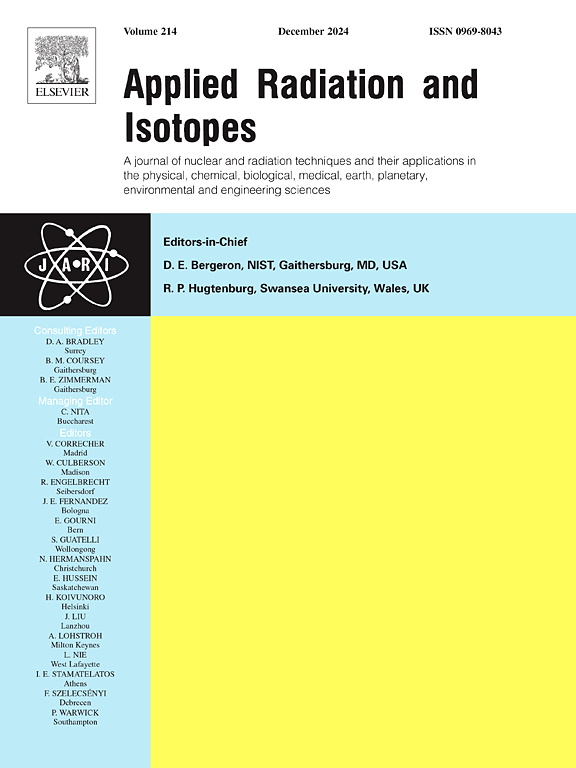Assessing the role of SiPM number on energy resolution in radiation detection using bismuth germanate crystals
IF 1.8
3区 工程技术
Q3 CHEMISTRY, INORGANIC & NUCLEAR
引用次数: 0
Abstract
In this study, we present a simple statistical model to show the relationship between the number of Silicon Photomultipliers (SiPMs) and the energy resolution of the detector. We used bismuth germanate (BGO) crystals in combination with varying numbers of SiPMs to examine the effect of photodetector count on energy resolution. We compared our results with Photomultiplier Tube-based measurements to determine the advantage of SiPMs in terms of energy resolution. We also performed a simulation study with the GEANT4 simulation package to investigate the energy resolution that can be achieved under ideal conditions by using a higher number of SiPMs. The experimental measurements showed that for a photopeak energy of 511 keV, an energy resolution of 29.9% was achieved using five SiPMs covering only 3.25% of the scintillator area, whereas a Photomultiplier Tube (PMT) covering 37% of the same area resulted in an energy resolution of about 23.4%. As a result of the simulation study, it is predicted that the energy resolution can be achieved up to 14.8% for a photopeak energy of 511 keV by using 21 symmetrically distributed SiPM.
锗酸铋晶体辐射探测中SiPM数对能量分辨率的影响
在这项研究中,我们提出了一个简单的统计模型来显示硅光电倍增管(SiPMs)的数量与探测器的能量分辨率之间的关系。我们使用锗酸铋(BGO)晶体与不同数量的SiPMs结合来研究光电探测器计数对能量分辨率的影响。我们将我们的结果与基于光电倍增管的测量结果进行了比较,以确定sipm在能量分辨率方面的优势。我们还使用GEANT4模拟包进行了模拟研究,以研究在理想条件下使用更高数量的sipm可以实现的能量分辨率。实验结果表明,当光峰能量为511 keV时,使用仅覆盖3.25%闪烁体面积的5个sipm,能量分辨率达到29.9%,而使用覆盖相同面积37%的光电倍增管(PMT),能量分辨率约为23.4%。仿真研究结果表明,在511 keV的光峰能量下,采用21个对称分布的SiPM可以达到14.8%的能量分辨率。
本文章由计算机程序翻译,如有差异,请以英文原文为准。
求助全文
约1分钟内获得全文
求助全文
来源期刊

Applied Radiation and Isotopes
工程技术-核科学技术
CiteScore
3.00
自引率
12.50%
发文量
406
审稿时长
13.5 months
期刊介绍:
Applied Radiation and Isotopes provides a high quality medium for the publication of substantial, original and scientific and technological papers on the development and peaceful application of nuclear, radiation and radionuclide techniques in chemistry, physics, biochemistry, biology, medicine, security, engineering and in the earth, planetary and environmental sciences, all including dosimetry. Nuclear techniques are defined in the broadest sense and both experimental and theoretical papers are welcome. They include the development and use of α- and β-particles, X-rays and γ-rays, neutrons and other nuclear particles and radiations from all sources, including radionuclides, synchrotron sources, cyclotrons and reactors and from the natural environment.
The journal aims to publish papers with significance to an international audience, containing substantial novelty and scientific impact. The Editors reserve the rights to reject, with or without external review, papers that do not meet these criteria.
Papers dealing with radiation processing, i.e., where radiation is used to bring about a biological, chemical or physical change in a material, should be directed to our sister journal Radiation Physics and Chemistry.
 求助内容:
求助内容: 应助结果提醒方式:
应助结果提醒方式:


